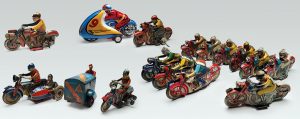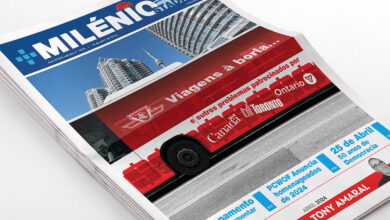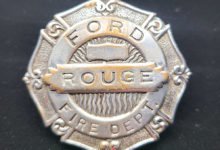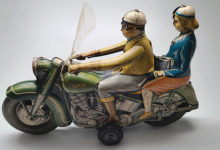Giocattoli Italiano

The last few articles were meant to stimulate the readers’ visual sense, both through article content and photos of a wide variety of lithographed motorcycle toys. We have already established that Germans have by far created the best examples which clearly illustrate graphics, detailing, and mechanical movements of motorcycle toys. Later, the Japanese arrived and attempted to be highly detailed with their own models. Basically, they were simply mimicking previously fabricated German designs. The Germans were un-matched toy fabricators and spared no expense to achieve the ultimate product. Their designs were reflections of the era and as inventions came to fruition, the toy designs were altered to reflect such inventions and appropriate timelines.
This week’s article will highlight two Italian toy manufacturers that have produced motorcycles which form part of the collection. The first is I.N.G.A.P., an acronym for “Industria Nazionale Giocattoli Automatici Padova”. Originally started production in Padova in 1919 and remained active until its closing in 1974. Most of their designs and products reflected what the masses were desiring. Most of their products were constructed of tin and were often very colourful and beautifully detailed. Products included trucks, cars, railway trains, airplanes, and my favourite of course, motorcycles. By far their largest output were undoubtedly model cars starting in the 1950’s. The initial series differed from the second series in that the second series had glazed side windows, windshield, and rear windshield. By this time, I.N.G.A.P. had moved away from tin and were heavily involved with mould injection technology. In the early 1960’s they began to manufacture American models in 1.87 scale, with a total number of 17 different models. Chassis and wheels were made of tin and rubber, while bodies were cheaply fabricated and unicoloured with little styling, in my opinion.
The second manufacturer is “FSC”, originally founded by Siro Ferrari in 1934 in Casalpusterlengo, Italy. The “FSC” is a combination of Siro’s name and his hometown. Experts agree that the toy industry grew by leaps and bonds in Germany, France, and England. With the end of the Second World War, it was Italy’s turn, with Ferrari’s manufacturing facility turning out hundreds and hundreds of toys. With the end of the war, the need for Iron and tin products was reduced and thus “FSC” began to strive. Inexpensive raw materials combined with great abundance made conditions ideal for Siro. Several other companies also thrived such as I.N.G.A.P., Centola, Piro, and Cardini. The end of the war also drastically altered the landscape and new materials were being introduced to replace tin toys. The greatest being “plastic” which almost replaced iron, tin, and wood overnight. Manufacturing was more efficient, cleaner, less expensive, but ultimately not as attractive to tin toy collectors. Later, battery, electric circuits, and transistors powered remote controls, eventually replacing traditional mechanical wind-up mechanisms, both fixed wind up and removable key types.
The collection contains 32 examples of toys from both manufacturers and the following are a few to stimulate your visual sense. Enjoy!
1930’s, 8” Long, I.N.G.A.P. Civilian Rider – Colourful, lithography, functioning exposed wind-up mechanism. Extremely detailed and retains much of its original gloss, and original double-sided fender plate 771-P.D.
1930’s, collection of three I.N.G.A.P. creations – 6” motorbike and sidecar, license plate 550 P.D., 6” single civilian rider, license plate 520 P.D., and “Grandi Magazzini” tricycle. Bright lithography and all mechanisms are functional.
1940’s & 1950’s examples of Siro Ferrari creations – 1940 model is 6” in length with internal windup mechanism. 1950 is 7” long, with very bright lithography, numbered “9” with internal friction mechanism.
1940 collection of Italian made “Penny” toys – Back row are all Siro Ferrari. Front row, 3 on the left are super rare “Centola” from Bologna. Front row on the right is a super rare “Pino”. Have never seen another. All motorcycles are freerolling.
Os meus artigos semanais têm o intuito de estimular os leitores com um sentido visual apurado, tanto através do conteúdo do texto, como pela variedade de fotografias das motocicletas de brinquedos litografados. Já assumimos que os alemães são de longe os que construíram os melhores exemplares que ilustram graficamente, detalhadamente e com os seus movimentos mecânicos. Mais tarde, os japoneses chegaram e tentaram ser altamente detalhados com os seus modelos próprios. Basicamente, estavam a imitar os designs previamente fabricados pelos alemães, mas os alemães eram incomparáveis em relação ao fabrico de brinquedos e não poupavam no custo para atingir o seu produto final. Os seus designs eram reflexo da era e com a chegada do usufruto das invenções, os seus designs eram alterados de modo a refletir tais invenções.
O artigo desta semana irá destacar duas fábricas de brinquedos italianas que produziram motocicletas de brinquedo que fazem parte da coleção. A primeira é a I.N.G.A.P., um acrónimo para “Industria Nazionale Giocattoli Automatici Padova”. Originalmente começou a sua produção em Padova em 1919 e continuou ativa até ao seu fecho em 1974. A maioria dos seus produtos eram feitos de lata e eram normalmente muito coloridos e excelentemente bem detalhados. Os seus produtos incluíam camiões, carros, comboios, aviões, e os meus preferidos, as motas. De longe, a sua maior venda eram os carros, sem quaisquer dúvidas, começando nos anos de 1950s. A série inicial diferenciava da segunda série que tinha janelas coladas nas laterais, para-brisas, e para-brisas traseiro. Por esta altura, a I.N.G.A.P. já tinha deixado a lata e era bastantemente envolvida em tecnologia de injeção de molde. No início dos anos da década de 60, começaram a fabricar modelos americanos em escala de 1.87, com um número total de 17 modelos diferentes. O chassis e as rodas eram feitos de lata e borracha, enquanto o corpo era fabricado de forma barata, com uma cor única, com muito poucos detalhes, na minha opinião.
O segundo fabricante é “FSC”, originalmente fundada por Siro Ferrari em 1934, em Casalpusterlengo, Itália. A “FSC” é uma combinação do nome de Siro e a sua cidade natal. Os conhecedores concordam que a indústria de brinquedos cresceu a saltos largos na Alemanha, França e Inglaterra. Com o fim da Segunda Guerra Mundial, era a vez da Itália, com as facilidades da Ferrari transformar centenas e centenas de brinquedos. Com o fim da guerra, a necessidade de produtos de lata e aço eram reduzidos e isso foi quando a “FSC” começou a subir. Materiais crus, baratos, combinados com abundância, proporcionaram as condições ideais para Siro. Várias outras empresas também subiram como a I.N.G.A.P., Centola, Piro e a Cardini. O fim da guerra também alterou drasticamente a paisagem, tendo sido introduzidos novos materiais para substituir os brinquedos de lata. O melhor era o “plástico” que quase substituiu o aço, lata e madeira do dia para a noite. Fabricar era mais eficiente, limpo, menos caro e, consequentemente, não tão atrativo como brinquedos de lata para colecionadores. Mais tarde, as baterias, circuitos elétricos, e controles remotos alimentados por transístores substituíram os mecanismos tradicionais de cordão mecânico, ambos as chaves de corda fixas e removíveis.

A coleção contém 32 exemplares de brinquedos de ambas as fábricas e os seguintes são para estimular o seu sentido visual. Aproveite!
8” de comprimento, I.N.G.A.P. Condutor Civil de 1930s – Colorido, litografado, mecanismo funcional de chave de corda. Extremamente detalhado e retém muito do seu brilho original, e matrícula 771-P.D. original em ambos os lados.
2Coleção de três criações da I.N.G.A.P. de 1930s – 6” de comprimento, motocicleta e carro lateral, matrícula 500 P.D., 6” de tamanho condutor único civil, matrícula 520 P.D., e triciclo “Grandi Magazzini”. Litografia brilhante e todos os mecanismos funcionais.
Exemplares da criação de Siro Ferrari de 1940s e 1950s – Modelo de 1940 com 6” de comprimento com mecanismo de corda interno. Modelo de 1950 com 7” de comprimento, com litografia bastante brilhante, numerado com o número “9” com mecanismo de fricção interna.
Coleção de brinquedos baratos feitos em Itália de 1940 – Na última linha são todos modelos Siro Ferrari. Na linha da frente, três à esquerda são “Centola” super raros da Bolonha. Na linha da frente à direita é um “Pino” muito raro. Nunca vi outro. Todas as motas são de rolamento livre.








Redes Sociais - Comentários